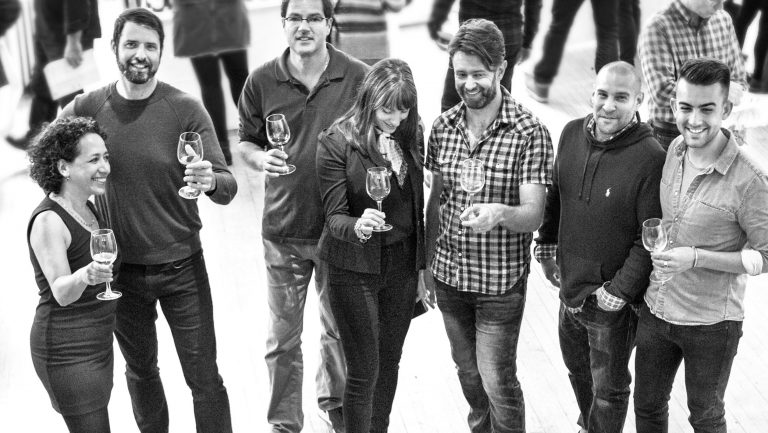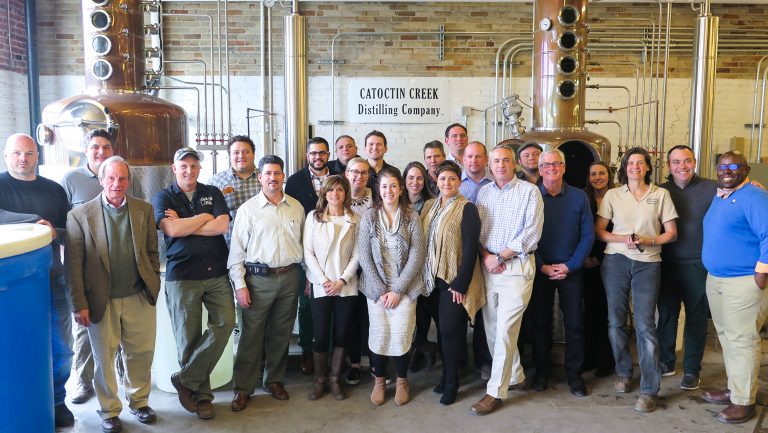In 2008, Michel Abood launched a one-man importing business based in New York City, armed with a handful of family-owned, value-oriented organic and biodynamic wines. A decade later, Abood, along with his business partner David Sugarman, has built Vinotas Selections, with offices in Manhattan and San Diego, into a top portfolio of small, environmentally conscious producers, with more than 100 wines at multiple price points available in 17 states.
Over the years, the goal—to champion boutique producers making high-quality wines according to organic, biodynamic, and natural principles—hasn’t changed, but the scope of the business certainly has. As Vinotas scales up to higher-end producers, new wine regions, and emerging U.S. markets, the team maintains a focus on providing value to both producers and buyers alike, sticking to its core philosophy to create sustainable growth.
Organic Value
Few would consider it a fortunate circumstance to open the doors of a new business on the day the stock market plummeted, but it may have been in the cards for Vinotas Selections; the recession ended up creating a demand for less expensive wines, like the ones in the Vinotas portfolio. A former lace designer who grew up between New York and Paris, spending summers in Toulouse sipping from his grandfather’s wine glass, Vinotas founder Abood long had a love of wine. After regularly discovering excellent but little-known, small-production French wineries during overseas travels, Abood left his job in 2006 in lace design and set out to found a national importing business.

Don’t miss the latest drinks industry news and insights. Sign up for our award-winning newsletters and get insider intel, resources, and trends delivered to your inbox every week.
While small groups within the industry at that time had begun to praise the virtues of organic, biodynamic, and natural wines, the movement hadn’t yet become widespread. But to Abood, focusing on environmentally conscious wines was a no-brainer. “You’re not only what you eat,” he says. “You’re also what you drink. It drives me up the wall when I go to Whole Foods and see people spending $40 on a free-range chicken, and then spending $5 on some corporate-made wine that’s full of chemicals.”
This strong connection to environmentally conscious wines was a key point of the founding mission of Vinotas, but so too was price point. “I noticed a dearth of offerings in the sub-$20 range in the organic, biodynamic, and natural space,” Abood says. “I want everybody to be able to afford a well-made wine that keeps both your palate and your intellect interested.” This turned out to be an advantageous strategy; in the first few years after the recession, Abood noticed that the average bottle price that he encountered at retail shops dropped from $30 to around $17. He says, “We were really at the perfect price point due to the economic conditions.”
As Abood steadily cultivated a reputation in this niche market, the economy recovered, giving Vinotas the ability to grow. Abood started looking for out-of-state distributor partners in 2012, and he brought Sugarman, a former high-tech sales specialist, on board in 2013. After selling only French wines initially, particularly from value-oriented regions like the Loire Valley, Languedoc-Roussillon, and Southwest France, the Vinotas partners expanded into Italian wine three years ago, again looking for small, family producers making organic, biodynamic, and natural wine. The Vinotas portfolio is currently made up of about 60 percent French wine and 40 percent Italian, and it includes three California producers distributed in New York.
Looking Up
Though Vinotas was based, in part, on the high proportion of bottles that would retail for less than $20, most of those ended up being from unconventional regions that necessarily offered greater value. Abood and Sugarman saw an opportunity to expand beyond this initial scope. “We took a look ahead and asked ourselves where we could find growth,” says Sugarman. “We really needed to be more in the prestige areas, getting on some of the finer wine lists and finding new customer types.” Particularly in New York, Sugarman notes, buyers were saying that Vinotas wines were too inexpensive to make business sense on a wine list.
Over the past year and a half, Vinotas has sought to discover new producers in line with the company’s core philosophies—but at higher price points in more classically prestigious regions, like Saint-Joseph’s Domaine Martine & Christian Rouchier or Barolo’s Franco Conterno. “It’s an extension of the same theme,” Sugarman says, “but with wines that fit into the mainstream.”
Lily Peachin, who founded Dandelion Wine Shop in 2008 and now owns the recently debuted Dandy Wine & Spirits, both in Brooklyn, has noticed the evolution of the Vinotas portfolio over the past decade and says it’s happily coincided with the trajectories of her businesses. “What kept us working together over the years,” she says, “were the good values that I would order over and over when I was just building my business, but now we can spend a little more on higher-end bottles. It’s not just Loire and Languedoc but Burgundy and Piedmont now too.”
That’s not to say that Vinotas’s new offerings don’t offer high value; the business still aims to represent wines that taste more expensive than they are. “The Rouchier Saint-Joseph in particular is a wine that I’ve been flying through,” says Ryan Davis, the wine director at Santina in Manhattan. “At $85 per bottle, it still totally outperforms its price point, but it’s a price that the restaurant owners are more comfortable with offering.”
In August 2018, Vinotas announced its partnership with the biodynamic producer Champagne Fleury, which was previously represented by Domaine Select. In a statement released to the public, Fleury family member and assistant winemaker Morgane Fleury noted that Vinotas’s environmentally conscious philosophy and focused portfolio gave the company the edge. She said, “We don’t want to be just another SKU in a large catalog of wines.”
Expanding Reach
Part of what is attractive about Vinotas to higher-end producers in more recognizable regions is the company’s distribution network. “The fact that we’re in 17 states gives added cache and leverage,” says Abood. “That definitely gives us an advantage.” Besides California, where Abood is based, New York, where Sugarman is based, and New Jersey, Vinotas partners with carefully vetted distributors in 14 other U.S. states, including Texas, Louisiana, Kentucky, Virginia, and most of the Northeast. Because the wine business is so regulated, and Vinotas doesn’t have the funding to set up multiple distributorships in other states, working with distributors is essential.
The move toward national distribution also benefits sales, allowing Vinotas to continue taking on new wineries for representation. “It’s a great way for us to grow very rapidly,” Abood says. He also adds that entering new markets allows Vinotas to diversify, which is key in today’s competitive landscape. “In 2012,” he says, “I thought that New York was already becoming saturated with importers and distributors.”
One thing that the Vinotas team has learned as the company’s range has broadened, however, is that top-selling wines vary from market to market. “Things that sell well in New York don’t necessarily sell well in the rest of the country,” Abood notes. “The general American palate does still like rounder, sweeter profiles, but that is changing and evolving.” Rather than bringing in wines that fall outside the overarching Vinotas style—lively fruit, notable minerality, and bright acidity, which essentially relate to the partners’ palate preferences—the partners rely on the fact that they purposefully seek out wines that taste accessible and steer away from the funk.
“We’re trying to sell the stuff that tastes normal,” Sugarman says, “that wouldn’t taste ‘natural’ unless we told you. That’s where we’ve found success up and down the price-point chain.” Adds Abood, “I grew up drinking classic wines, and I want environmentally sound wines to taste classic.” This offers value to buyers like Davis, who says that “this approach allows me to sell sustainable and responsibly produced wines to a mainstream audience in the Meatpacking District.”
Looking ahead to what Sugarman refers to as Vinotas 2.0, the company plans to continue its trajectory of seeking out higher-end producers in new regions (Abood has tossed around the idea of representing some Spanish producers, but he wants to do so thoughtfully). Vinotas also plans to focus on growing the number of wines from the portfolio’s existing producers, noting that it’s a good way to increase sales while adding value for buyers.
The key to continued success amid all this growth, from Vinotas’s perspective, is to always return to the company’s core mission: to represent small, family-owned producers making excellent wines and working in organic, biodynamic, or natural ways. “We’re growing slowly and organically,” Abood says, “and that’s exactly what I want.”

Dispatch
Sign up for our award-winning newsletter
Don’t miss the latest drinks industry news and insights—delivered to your inbox every week.
Courtney Schiessl Magrini is the editor-in-chief for SevenFifty Daily and the Beverage Media Group publications. Based in Brooklyn, she has held sommelier positions at some of New York’s top restaurants, including Marta, Dirty French, and Terroir, and her work has appeared in Wine Enthusiast, GuildSomm, Forbes.com, VinePair, EatingWell Magazine, and more. She holds the WSET Diploma in Wines. Follow her on Instagram at @takeittocourt.







